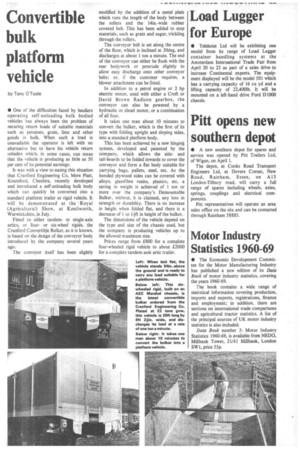Convertible bulk platform vehicle
Page 31

If you've noticed an error in this article please click here to report it so we can fix it.
by Tony O'Toole • One of the difficulties faced by hauliers operating self-unloading bulk bodied vehicles has always been the problem of securing return loads of suitable materials such as potatoes, grain, lime and other goods in bulk. When such a load is unavailable the operator is left with no alternative but to have his vehicle return unladen which, in some cases, can mean that the vehicle is producing as little as 50 per cent of its potential earnings.
It was with a view to easing this situation that Cranford Engineering Co, Mere Platt, Knutsford, Cheshire, recently developed and introduced a ielf-unloading bulk body which can quickly be converted into a standard platform trailer or rigid vehicle. It will be demonstrated at the 'Royal (Agricultural) Show, at Kenilworth, Warwickshire, in July.
Fitted to either tandemor single-axle artics, or fouror six-wheel rigids, the Cranford Convertible Bulker, as it is known, is based on the design of the conveyor body introduced by the company several years ago.
The conveyor itself has been slightly modified lay the addition of a metal plate which runs the length of the body between the rollers and the 14in.-wide rubber covered belt. This has been added to stop materials, such as grain and sugar, trickling through the rollers.
The conveyor belt is set along the centre of the floor, which is inclined at 30deg, and discharges at about 1 ton a minute, The end of the conveyor can either be flush with the rear bodywork or protrude slightly to allow easy discharge onto other conveyor belts; or, if the customer requires, a blower attachment can be fitted.
In addition to a petrol engine or 2 hp electric motor, used with either a Croft or David Brown Radicon gearbox, the conveyor can also be powered by a hydraulic or diesel motor, or a combination of all four.
It takes one man about 10 minutes to convert the bulker, which is the first of its type with folding upright and sloping sides, into a standard platform body.
This has been achieved by a new hinght system, developed and patented by the company, which allows the sideand tail-boards to be folded inwards to cover the conveyor and form a flat body suitable for carrying bags, pallets, steel, etc. As the bonded plywood sides can he covered with alloys, glassfibre resins, plastics, etc, a saving in weight is achieved of 1 ton or more over the company's Demountable Bulker, without, it is claimed, any loss in strength or durability. There is no increase in height when folded flat, and there is a decrease of 1 to lift in height of the bulker.
The dimensions of the vehicle depend on the type and size of the chassis used, but the company is producing vehicles up to the allowed maximum size.
Prices range from £800 for a complete four-wheeled rigid vehicle to about £2000 for a complete tandem-axle artic trailer.




























































































